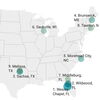More move to the cloud as ME data cos. prepare for boom
 photo/TIM GREENWAY
Ron Shink, chief technology officer for Oxford Networks, in the server room at Oxford Networks' Data Center in Brunswick
photo/TIM GREENWAY
Ron Shink, chief technology officer for Oxford Networks, in the server room at Oxford Networks' Data Center in Brunswick
Behind the black door at its high-security data center in Brunswick, Oxford Networks is preparing for one of information technology's fastest-growing markets.
Next year, the facility that opened in July will increase computing power ninefold at its labyrinthine data center, anticipating that more businesses will outsource IT support and move to "the cloud."
That means more companies reducing on-site IT infrastructure and contracting with web-based services.
While no other building in the United States shares the design of Oxford's Brunswick data center — a bomb-proof bunker burrowed into the soil at the former Brunswick Naval Air Station — the company is hardly alone in competing for cloud customers.
"It's clearly the way of the future," says Ron Shink, Oxford's chief technology officer.
Oxford's expansion is in preparation for companies like Martin's Point Health Care, which will outsource management of its electronic health records and billing system to a cloud-based service from athenahealth starting in May 2013. Martin's Point's decision to contract with a cloud-based software provider signals a growing market and an increasing comfort with putting a business' core functions into cloud environments, a national trend playing out here in Maine. Industry analysts at Cisco estimate that nearly two-thirds of all data center workloads will be processed in the cloud by 2016. Until then, according to its 2012 report, growth in cloud computing is expected to outpace growth of traditional server use by five-and-a-half times.
Why the move?
Cloud comfort was hard-won for Martin's Point CEO and President David Howes, who says the health care network spent a year kicking the tires on the decision. "If you really want to know how it works out, call us in June," Howes says.
"I had a lot of concerns about security," he says. "We've had to size up a lot of risks that other organizations might not have to worry about."
Hospitals and other health care organizations regularly deal with information protected under the Health Insurance Portability and Accountability Act, or HIPPA, which requires their data systems to meet certain security standards. For that reason, Martin's Point has to ensure a high level of the security for the data maintained its nine locations. But health care isn't the only industry with strict data standards — banks are another — and security and reliability are, broadly, the two concerns prospective customers have to be assured of.
"If we lose [access to electronic records] for a day, we'll probably have a couple thousand office visits that have gone without support or without being recorded," Howes says, reflecting on when he first began practicing medicine and paper records were the norm. Although paper carried fewer security threats, it can't compete in providing a doctor detailed patient background information instantly.
Howes says he expects the cloud-based service will enhance reliability and security over the company's present in-house electronic record system and gives a nod to the investment athenahealth put into its cloud software.
"I came to realize that [athenahealth] could also put 100 times more thought into security than we could as a small, local organization," Howes says.
Cost was a non-issue.
"It came to a price that was about equal" with keeping those systems managed in-house, Howes says. "[Going to the cloud] allows us to focus on providing health care, so that's what we needed to make the decision."
An ability to focus on core services is the same rationale Paul Lones, senior vice president for information technology at Fairchild Semiconductor in South Portland, cites for his company's steady transition to more cloud-based services. It started three-and-a-half years ago, when the company moved 6,500 of its employees worldwide to Google's suite of web applications, including general communication services like email.
"We have seven factories worldwide, so communication and collaboration tools are very core to our business, but they're not unique to our business like our manufacturing systems," Lones says.
Confronted with a decision whether to upgrade its internal data system and renew its commitment to maintaining certain internal IT systems, Lones said the company weighed its options. As with Martin's Point, there were no significant cost differences, he says, but there were advantages.
Cloud services added convenience for employees to access office resources and have also cut the time required for implementing system upgrades. Additionally, it reduced the company's need to invest in the on-site hardware to handle communications, human resources and customer management programs. Now Fairchild uses cloud-based services in areas where it does not need a high level of customization.
"A consideration is 'Are we going to want to customize things in these sorts of application spaces?'" Lones says. "Do we want to customize the email experience? No. Do we want to customize payroll? The answer is 'No.'"
The company employs Workday's cloud-based software for human resources, Salesforce.com's customer relations software and will soon move its shared data storage into the cloud through Google's Drive service.
"We're able to focus more on in-house or industry-specific applications [around manufacturing semiconductors] that are proprietary and we let another partner manage these products in other areas like communications and collaboration and [customer relations]," says Lones.
Pick and choose
The development of cloud-based services for discrete tasks is allowing businesses like Lewiston-based FISC Solutions to pick and choose where cloud computing makes sense. FISC, a payment processing and business support company, uses cloud-based HR and customer relationship software and moved its own IT infrastructure to Oxford Networks' Brunswick data center this year.
In that sense, FISC is maintaining a traditional server structure, albeit off-site, but Kevin Broughton, FISC's senior vice president of information technology and operations, predicts that the economics of cloud computing might soon drive companies like FISC from their own hardware and onto cloud systems.
"I think it's the start of a transition," Broughton says. "As facilities become more commoditized and as the price point is driven down, it becomes harder to justify using your own system."
That's a trend Oxford Networks' CTO Shink is betting on. Oxford declined to say just how much it's spending to build out around 8,000 more square feet of computing space at its Brunswick facility, but the company has, so far, invested $6 million in the high-security data center.
"There are pieces of a business that make sense to [move to the cloud] today and there are more sophisticated pieces that require higher levels of examination," Shink says. He predicts that security features will continue to improve as more workloads consolidate to cloud environments.
The cloud game
Cisco's projection that two-thirds of all data center workloads will be processed in a cloud environment is based largely on economics: Cloud environments use processing power and computer resources more efficiently than traditional servers.
Essentially, cloud computing breaks down the idea that a computer is a distinct unit, a computing method called virtualization. That allows a large pool of resources — processors, RAM, disk space — to be assigned to workloads as needed, maximizing the utility of the resources on hand and, as a result, reducing overhead for companies providing data hosting services.
On average, Shink says, a server uses 10% of its processing power. Virtualization allows a processor to process multiple workloads at once, using a processor's full capacity and allowing the scaling of resources to meet computing demand.
That means customers can purchase the specific computing power needed for a job rather than investing in hardware to match a maximum computing need.
Larger cloud service providers such as Amazon and Google are prompting global changes in the market. But here in Maine, companies such as Oxford Networks, GWI and EarthLink are preparing to capture a regional market where they see an opportunity to provide more customized service.
"There's a race out there but it depends on the market space that you're going after," says Glen Mulhare, a senior IT consultant with EarthLink. The company is looking to carve out a regional niche of the cloud market in Maine to serve small-to-medium-sized businesses.
Whereas companies like Amazon and Google are focused on providing largely self-service cloud services at high volume, EarthLink's Scarborough branch manager, Mark Clements, says the company is emphasizing "consultative sales" for the businesses that don't have the resources to take on a migration to the cloud independently.
Oxford and GWI are taking a similar approach to the market, leveraging networks and physical resources located in the state to create more customized network solutions that might combine a variety of services.
But the broad adoption of cloud services through Amazon and Google is creating a market where the cloud is becoming more familiar. Mulhare says the idea of cloud-based software — the market segment called software as a service, or SaaS — is gaining familiarity through companies like Salesforce.com and Google.
"The question is, do they want to put their whole infrastructure or mission-critical information on the cloud?"
According to analysts at Gartner Inc., an international IT consulting company based in Connecticut, the companies willing to move computing off of their own infrastructure and into cloud environments — the segment called infrastructure as a service, or IaaS — is estimated to be the fastest-growing area of the cloud computing industry in 2012. Worldwide, Gartner estimates that cloud market segment generated $4.2 billion in revenue for 2011 and will, by 2016, generate over $24.4 billion.
Greater access
Thanks to the September completion of Maine's Three Ring Binder project — a 1,100-mile fiber optic network — more Maine companies can consider whether cloud services are a good fit. Fletcher Kittredge, CEO of Biddeford-based GWI, whose company championed the Three Ring Binder project, says the new infrastructure "was designed for cloud computing," right down to the shape of the three circuits that run through the eastern half of the state from Fort Kent to Kittery.
"You can cut it in one place and everyone can still talk to each other," Kittredge says. "You can route around the ring and get to the same place. As you add more rings, you can tolerate not just one cut but multiple cuts."
That level of reliability is not possible with the piecemeal infrastructure that the Internet has so far piggy-backed on, Kittredge says.
Having a data network designed with reliability and security in mind, Kittredge says, will be the foundation for growth in cloud services here. To date, 12 customers were leasing fiber on the network and 29 others had submitted applications to lease bandwidth on the network Kittredge says.
Shink agrees that infrastructure will be key to opening that new market.
"We tried to do this back in the 1980s when everyone was looking at doing something similar to cloud computing, but we didn't have the networks and the bandwidth back then," Shink says. "Our network and the compression factors are getting better and better and that's what makes this real now."
Read more














Comments